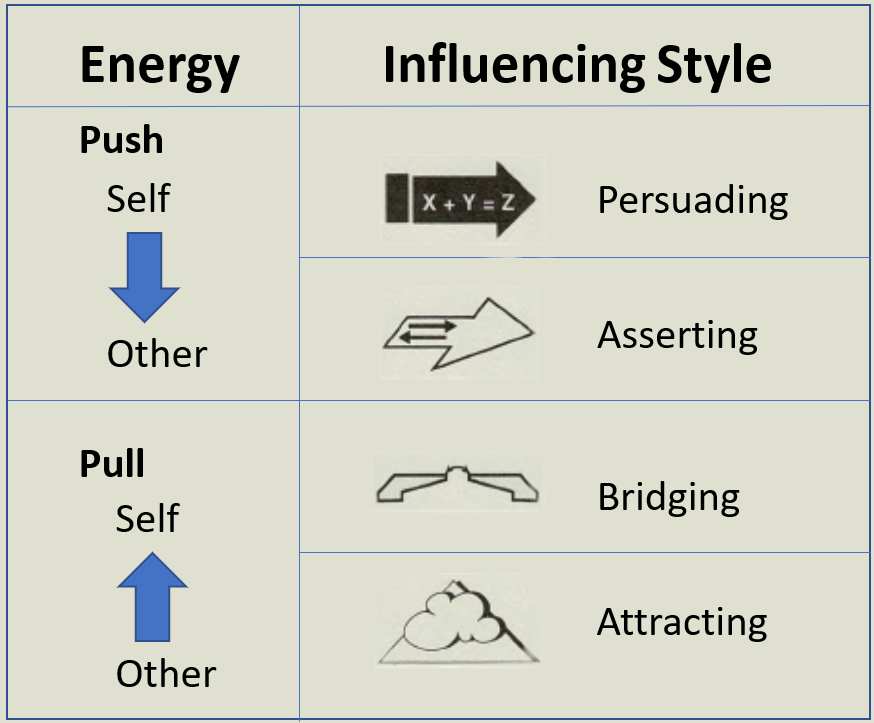In the 1980s, when I was working as a manager for Digital Equipment Corporation, I attended a Positive Power and Influence Program developed by Situation Management Systems where I learned about different influencing styles. The following is a summary of what I learned about from that program.
Why should a small business owner care about their Influencing Styles? Because effective leadership, as well as any form of sales, relies on your ability to influence others to accomplish your objectives. Influence can come in the form of impacting the other person’s ideas, opinions, and even their actions. As a business owner, your success often depends on your ability to effectively influence people both over whom you have control, and whom you have no direct control.
We all have a predominant influencing style when working with others. However, we often need to have situational flexibility and be able to change our influencing style based on various conditions.
Being aware of our predominant influencing style and having the ability to observe them used by others is critical in today’s fast-paced and stressful work environments. When you unconsciously adopt a predominant influencing style and do not see the expected results, most people will have the tendency to simply intensify their predominant style rather than consciously choose a different style based on the situation.
The four most effective situational influencing styles use either a push energy or pull energy at their core.
Push Influencing Styles Energy
Influencing styles with push energy involve Persuading or Asserting your position. Influencing styles that use push energy are the best if you already have some type of influence, such as positional power. Push influencing energy is good at gaining compliance to achieve your objective.
Ideally, with any push energy influencing style you want to be viewed as dynamic and pushing things forward, and not as trying to steamroll over others.
Persuading Influencing Style
The first influencing style is Persuading also sometimes called Rationalizing. When we attempt to persuade others, our behaviors involve either proposing ideas, making suggestions, providing recommendations, or applying reasoning by providing facts in support or in opposition to our position.
When it comes to persuading, the leader does not have positional power but they must either have exclusive information or be working with another party that respects their competence. Also, the topic must be relatively unemotional and you must be perceived as objective. To make the most of persuading, the leader needs to have identified some common ground to build upon.
In the persuading influencing style, you use logic, data, and rational and coherent arguments to list the facts that support your objective. You will encourage the other party to analyze the information you have laid out, think logically, and follow your recommended course of action.
Asserting Influencing Style
The second influencing style is Asserting. Attempting to assert our influence over others our behaviors involves evaluating and stating our expectations through demands, imposing standards, providing a prescription, or using incentives or pressure to control others.
When it comes to asserting, the leader must have positional power where they can exert incentives and pressures and be content with simple compliance, rather than the other party’s full commitment.
In the asserting influencing style, you need to be clear about what you want. It is best when both parties know that they have something to either gain or lose. The asserting influencing style often results in some level of bargaining and negotiation to come up with an outcome that is acceptable for both parties.
Pull Influencing Styles Energy
Influencing styles with push energy involve Bridging and Attracting. Influencing styles that use pull energy are particularly effective in situations where you do not have any authority over the other party, and are good at winning over the hearts and minds of others.
Ideally, with any pull energy influencing style, you want others to be drawn to you and your objectives so they want to work with you. You do not want to be viewed as manipulative or disingenuous.
Bridging Influencing Style
The third influencing style is Bridging. When we attempt to bridge, our behaviors involve the other party through solicitation and encouraging participation, or we employ listening skills and paraphrase and summarize the other position.
A common bridging tactic is to disclose mistakes that you have made to make yourself appear vulnerable and then ask for help. Bridging is particularly effective when there are emotions involved and the other person is just as committed to the outcome as you are.
Bridging is an effective influencing style when you have no authority over the other party, are open to being influenced, and value their contribution and commitment. Bridging allows you to build relationships and make connections so that you can demonstrate that you see the other party’s perspective.
Attracting Influencing Style
The last influencing style is Attracting sometimes called Inspiring. When we attempt to attract others to our position, our behaviors involve either finding common ground by highlighting our common values and beliefs or employing “visioning”, where we use a metaphor or analogy to paint a picture of our desired outcome.
When it comes to attracting, your goal is to align both parties through shared common values and gaining the other person’s trust. You want to create excitement in the other person so they are energized and motivated to achieve the objective.
The attraction influencing style is an effective style when you have no authority over the other party and you are personally committed to the objective, and the other party has a role in supporting your objective.
There are technically two other influencing styles that have a moving away energy. Disengaging is where you allow the other party to think and reflect for a while with the intent of resuming the discussion at a later date. The other is Avoiding, which is where you back down and simply abandon your position altogether.
Not every influencing style works in every situation. Savvy entrepreneurs are willing to change their influencing style based on different situations.
How adept are you at understanding and changing your influencing behaviors based on different situations?
Related Post: 16 Powerful Principles to Influence a Sale












